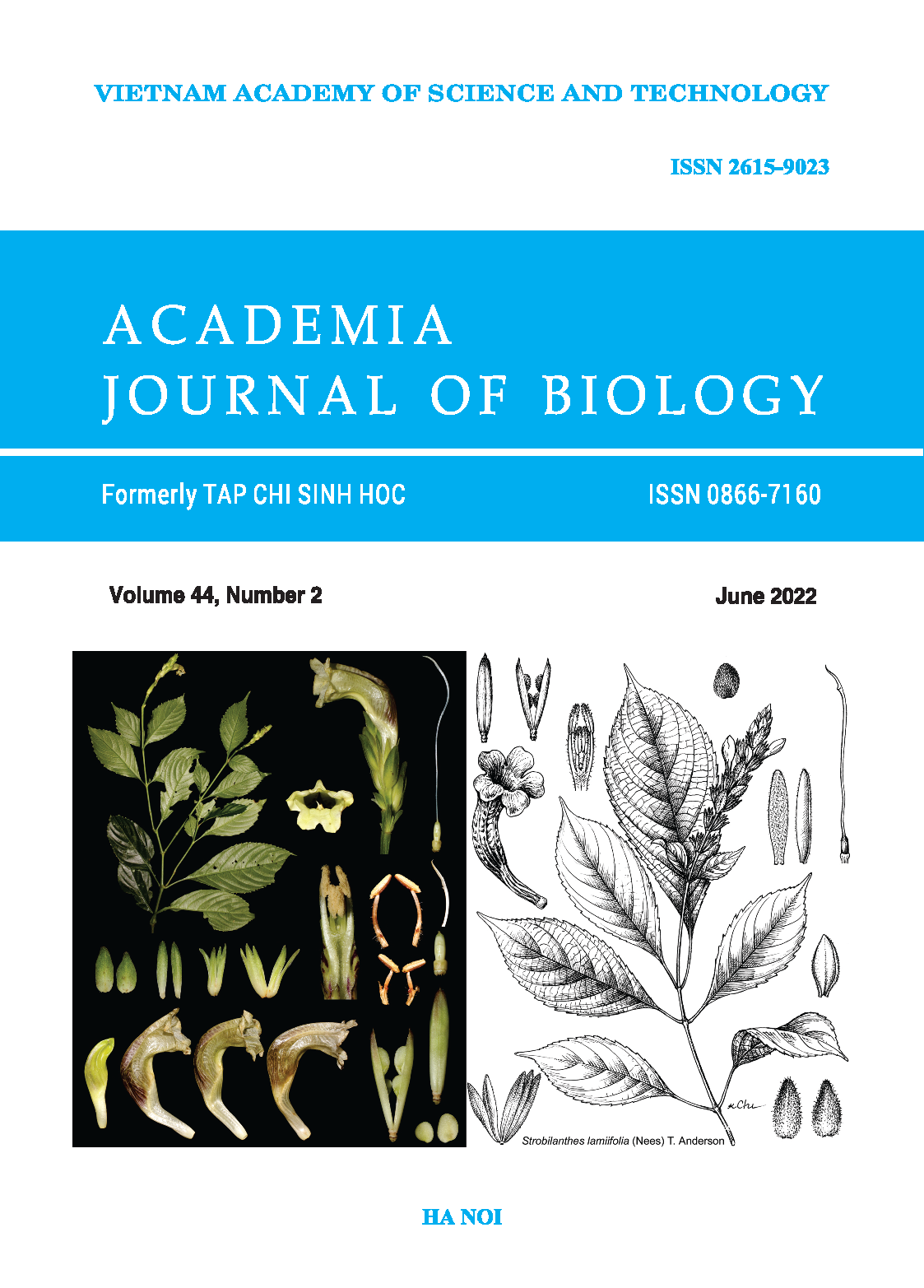Selection of suitable growing substrates and quality assessment of Brassica microgreens cultivated in greenhouse
Author affiliations
DOI:
https://doi.org/10.15625/2615-9023/16833Keywords:
greenhouse microgreens, growing media, fresh weight, dry weight.Abstract
Brassica microgreens are typically cultivated using a peat-based growing substrate with a higher production cost as this substrate must be imported from overseas. In Vietnam, a source of local bio-materials that could be used to replace imported peat, resulting in more affordable growing substrates. Several growing substrates for Brassica microgreens were evaluated in this study: GT1 (30% sand +20% organic soil + 50% coco coir), GT2 (75% coco coir + 25% rice husk), GT3 (75% coco coir + CaO 2.2 mg/kg + acid humic 0.41%) and imported peat GT4 (75% white sphagnum peat +25% vermiculite (size 4–6 mm). The local organic material coco coir GT3 was found to be as effective as the imported substrate for microgreen production. The material coco coir mixed with soil and sand could increase the risks of soil-borne disease infestation on Brassica microgreens. Microgreens grown in the substrate GT3 and GT4 had higher productivity and lower disease infestation levels than other tested substrates. Nitrate level and microbiological contamination (E. coli and Salmonella spp.) of Brassica microgreens cultivated in these substrates were determined to be at safe levels.
Downloads
References
Regulation E. C., 2011. Regulation (EC) Nº 1258/2011 of 2 December 2011 amending Regulation (EC) No 1881/2006 as regards maximum levels for nitrates in foodstuffs. In Official Journal of the European Union.
Abad, Manuel, Patricia Noguera and Silvia Bures, 2001. National inventory of organic wastes for use as growing media for ornamental potted plant production: a case study in Spain. Bioresource Technology, 77(2):197−200.
Balkhair, Khaled S., 2016. Microbial contamination of vegetable crop and soil profile in arid regions under controlled application of domestic wastewater. Saudi Journal of Biological Sciences, 23(1): S83−S92.
Bewley, Derek J., 1997. Seed germination and dormancy. The Plant Cell, 9(7):1055.
Gioia, Francesco D., Palmira De Bellis, Carlo Mininni, Pietro Santamaria and Francesco Serio, 2017. Physicochemical, agronomical and microbiological evaluation of alternative growing media for the production of rapini (Brassica rapa L.) microgreens. Journal of the Science of Food and Agriculture, 97(4): 1212−1219.
Ha N. N., Nguyen T., Nhung and Nguyen Thuy Nga, 2011. Potential Use of Some Media for Growing White Radish Sprouts with Safety and High Quality in Household Scale. Journal of Science, Faculty of Environmental Sciences, VNU University of Science, 32:413−418.
Holmer R., Linwattana G., Nath P. and Keatinge J. D. H., 2013. High-value vegetables in Southeast Asia: production, supply and demand; Proceedings-SEAVEG 2012. Proceedings of the Regional Symposium on High-Value Vegetables in Southeast Asia: Production, Supply and Demand (SEAVEG2012).
Iammarino, Marco, Aurelia Di Taranto and Marianna Cristino, 2014. Monitoring of nitrites and nitrates levels in leafy vegetables (spinach and lettuce): a contribution to risk assessment. Journal of the Science of Food and Agriculture, 94(4):773−778.
Johnny, 2017. Johnny’s 2017 microgreens yield data trial. edited by Johnny’s Selected Seeds.
McGehee, Cora S., Rosa E. Raudales, Wade H. Elmer, and Richard J. McAvoy., 2019. Efficacy of biofungicides against root rot and damping-off of microgreens caused by Pythium spp. Crop Protection, 121: 96−102. https://doi.org/10.1016/j.cropro. 2018.12.007
Muchjajib U., Muchjajib S., Suknikom S. and Butsai J., 2014. Evaluation of organic media alternatives for the production of microgreens in Thailand. XXIX International Horticultural Congress on Horticulture: Sustaining Lives, Livelihoods and Landscapes (IHC2014): 1102.
Murphy M., Carrie J., Kenneth F. L. and Wallace G. P., 2010. Factors affecting the growth of microgreen table beet. International Journal of Vegetable Science, 16(3): 253−266.
Nolan, Donielle A., 2019. Effects of Seed Density and Other Factors on the Yield of Microgreens Grown Hydroponically on Burlap. Master, Verginia Tech.
Santamaria, Pietro, 2006. Nitrate in vegetables: toxicity, content, intake and EC regulation. Journal of the Science of Food and Agriculture, 86(1):10−17.
Soane B. D., 1990. The role of organic matter in soil compactibility: a review of some practical aspects. Soil and Tillage Research, 16(1−2): 179−201.
Sven, Verlinden, 2020. Microgreens. In Horticultural Reviews, edited by I. Warrington: 85−124.
Thuong Vu Thi and Hoang Gia Minh, 2020. Effects of growing substrates and seed density on yield and quality of radish (Raphanus sativus) microgreens. Research on Crops, 21(3): 579−586. https://doi.org/10.31830/2348-7542.2020.091
Treadwell D. D., Hochmuth R., Landrum L. and Laughlin W., 2010. Microgreens: a new specialty crop. University of Florida IFAS Extension.
Weber, Carolyn F., 2017. Broccoli microgreens: A mineral-rich crop that can diversify food systems. Frontiers in Nutrition, 4: 7.
WHO, 2011. Nitrate and nitrite in drinking-water: Background document for development of WHO Guidelines for Drinking-water Quality. World Health Organization: World Health Organization.
Xiao, Zhenlei, Gene E. L., Yaguang Luo and Qin Wang, 2012. Assessment of vitamin and carotenoid concentrations of emerging food products: edible microgreens. Journal of Agricultural and Food Chemistry, 60(31): 7644−7651.
Xiao, Zhenlei, Gene E. L., Eunhee P., Robert A. S., Yaguang L. and Qin Wang, 2015. Evaluation and correlation of sensory attributes and chemical compositions of emerging fresh produce: Microgreens. Postharvest Biology and Technology, 110: 140−148.
Xiao, Zhenlei, Yaguang Luo, Gene E. L., Liping Kou, Tianbao Yang and Qin Wang, 2014. Postharvest quality and shelf life of radish microgreens as impacted by storage temperature, packaging film, and chlorine wash treatment. LWT-Food Science and Technology, 55(2): 551−558.
Downloads
Published
How to Cite
Issue
Section
License
Academia Journal of Biology (AJB) is an open-access and peer-reviewed journal. The articles published in the AJB are licensed under a Creative Commons Attribution-NonCommercial-NoDerivatives 4.0 International License (CC BY-NC-ND 4.0), which permits for immediate free access to the articles to read, download, copy, non-commercial use, distribution and reproduction in any medium, provided the work is properly cited (with a link to the formal publication through the relevant DOI), and without subscription charges or registration barriers. The full details of the CC BY-NC-ND 4.0 License are available at https://creativecommons.org/licenses/by-nc-nd/4.0/.












